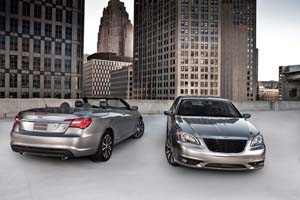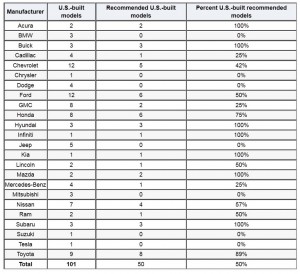There’s been a lot of talk about the comeback of the “American” auto industry in recent months. And if you’re specifically discussing Detroit’s so-called Big Three, there are clearly signs they are on the mends following the near collapse of the Motor City in 2009.
But what really defines an American car company? These days, you’re likely to see TV commercials from a variety of brands all claiming that patriotic designation. BMW, Toyota, Hyundai, Subaru and Volkswagen are among the many foreign-owned makers who have emphasized their U.S. plant in a series of spots aired in recent months.
Clearly, the definition has blurred now that there are more than a score of “transplant” assembly plants operating on U.S. shores. So, that got the folks at Consumer Reports looking more closely at the list of products you’ll find at nearby showrooms to see which models actually roll off American assembly lines.
The non-profit publication counted 101 mainstream vehicles that qualified – though the number expanded significantly if you counted all the various trim packages. And when it came to which makers led and lagged there were some surprises.
Dominating the list were Chevrolet and Ford, with an even dozen each. At the other end of the spectrum, the Chrysler brand had just one, it’s new 200 model – which was the offering spotlighted by the maker’s high-profile “Imported from Detroit” ad campaign.
Add in all of its four surviving brands and GM had 27, Ford 14.
Toyota had the highest total among foreign-owned makers, with 9 U.S.-made offerings (though none wearing the Japanese giant’s Lexus or Scion brand badges). GMC and Honda followed, with 8 each, Nissan close behind with 7.
To complicate the picture, Consumer Reports also tallied up the number of American-made models that earned a recommendation from the magazine’s automotive editors. There, Toyota grabbed the lead, with 8, while Honda and Ford had 6 each, Chevrolet 5.
But hoping not to add further confusion, CR noted that 100% of the American-made models offered by seven makers got that coveted Recommended Buy rating: Acura, Buick, Hyundai, Infiniti, Kia, Mazda and Subaru. For Chrysler, it was a goose egg, the new 200 model not on the magazine’s list.
The story could, of course, get even more confusing were CR to have also considered where makers like Chevy, Toyota and Hyundai source their parts. Many models assembled in the U.S. rely on engines, transmissions and other components, large and small, imported from abroad.



I have to wonder about the accuracy of the CR data when I look at it and know that no Infiniti model is built in the US…
In articles such as this, the term “American Made” always should be replaced by the more-accurate description of “American Assembled.”
Hi, Lee,
It really does require careful verbiage, doesn’t it. I’ll keep your point in mind.
Paul A. Eisenstein
Publisher, TheDetroitBureau.com
Part of the problem is the measurement of “American” meaning nothing more than “assembled in USA”. I suggest a new measurement called “Nations without protectionist and preditory trade practices”. I define this as nations which practice free-trade; meaning no tariffs, value-added taxes, bureaucratic red-tape designed to stall imports at the border, etc.
Suddenly Canada as Mexico are in the picture as “North American” because unlike virtually the rest of the world, they don’t put up barriers to US-made imports. As a result, US-made vehicles compete successfully in these nations, benefitting US workers.
Compare that to Germany which adds a 19% VAT to any vehicle imported from North America… Taking the price of a Jeep Liberty over $10,000 higher than a VW Tiguan, which is within $200 of the Liberty in the US. Similar examples abound throughout Europe and Asia.
BTW, not just an “American” problem… Protectionist policies mean the Japanese control less than 2% of the Korean market, and Korean sales in Japan amounted to just 502 in 2008, a market that sold around 6-million units that year, IIRC.
Assembly is also the least value-added component of vehicle production, the majority of better paying jobs (and spin-off jobs) comes from engineering, R&D, finance, accounting, etc. Asian and Euro brands have only a token presense in this nation, while the D3 employ tens of thousands.
In simple terms, an American who purchases a Chrysler Town & Country built in Canada does a lot more economic good for the U.S. for the following reasons:
1) U.S.-made Chrysler products flow directly into Canada without additional tariffs (Chrysler #2 in Canadian sales).
2) Design, testing, tooling, metal stampings, all come from the U.S.
3) Entire driveline (engine, transaxles) built in U.S.
Contrast this to Consumer Reports ranking Suzuki as “equal” to Chrysler.
1) Trade policies allowing American imports to Japan are still heavily protectionist.
2) All Design, R&D, “back office functions” performed in Japan.
3) Major components and drivetrain sourced from Japan.
Sorry Consumer Reports, but this is another example of cherry-picking data to serve a pre-determined outcome.
(And as the previous poster pointed out, no Infinity models produced in the US. Limiting Chrysler to one model, but assigning 4 to Mercedes is also laughable. I assume they are classifying the 200c sedan/convertible as one model, but they’ve found a way to classify Mercedes variations of the ML series as “4”?)
Thanks, Carmine, for some very interesting points. It’s very easy to bend data to serve one’s point (as I just scolded another commenter who routinely distorts the data to justify his highly-politicized worldview).
Paul E.